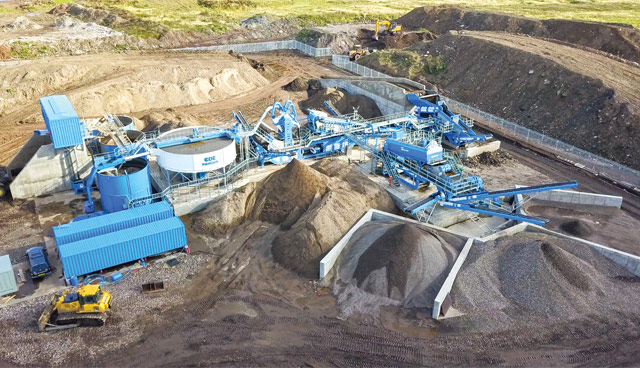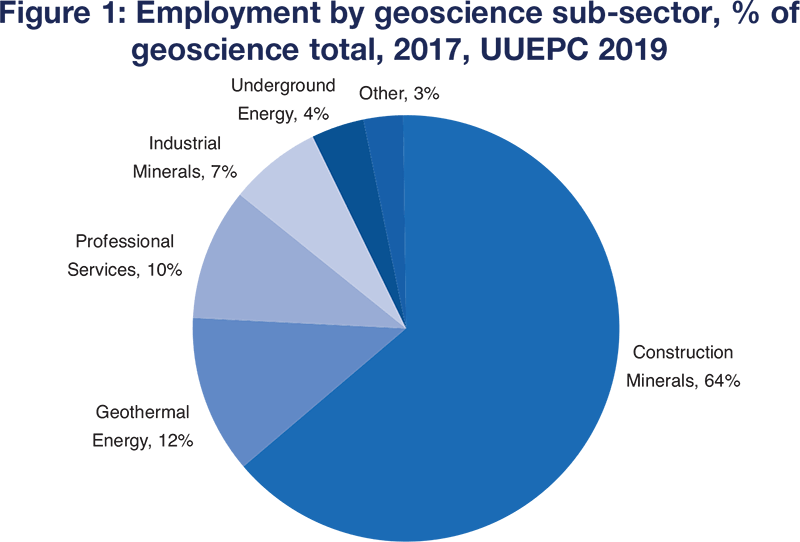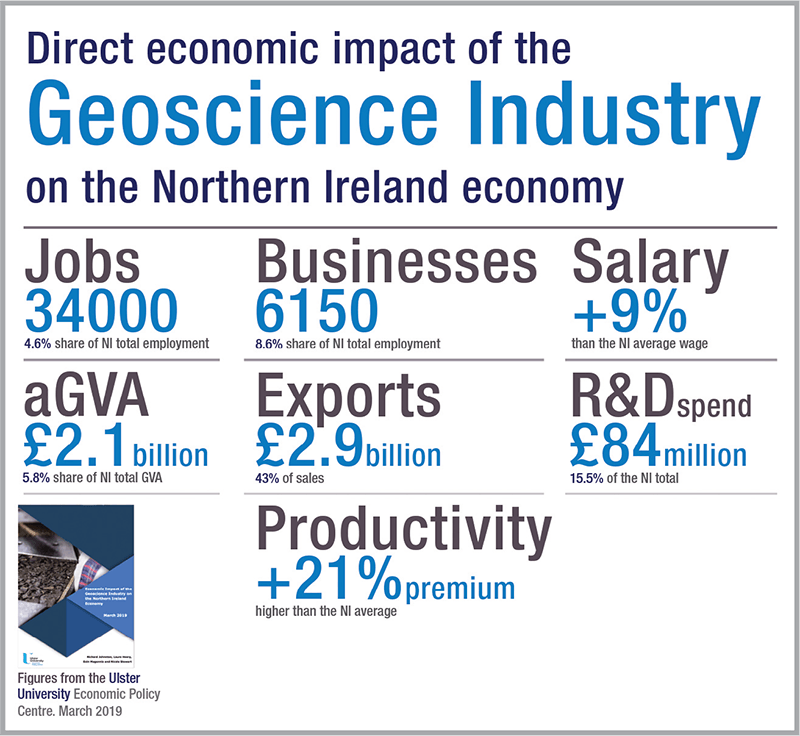Geoscience industry and the economy

Minerals are essential to support sustainable development; a sufficient and secure supply of raw materials is required for manufacturing, construction, power and heat generation, transport and agriculture. The Department for the Economy looks at the direct economic impact of Northern Ireland’s geosciences sector.
The Department for the Economy (DfE) commissioned the Ulster University Economic Policy Centre (UUEPC) “to research the economic value and impact of the geosciences sector to the Northern Ireland economy and consider the potential of that sector to further benefit the economy”. The UUEPC’s full report is published online1.
Geoscience industry sectors
The UUEPC report breaks down its data analysis of the geoscience sector from the relevant 2007 Standard Industrial Codes (SIC07) at the 5-digit level standard industry codes (SIC07) in two ways; 1) core and non-core activities and 2) eight sub-sectors.
Core activities which directly support the industry include the extraction of minerals (mining and quarrying activities), connected industries to this (mining machinery) and the production of materials/goods from the minerals (e.g. manufacture of concrete or cement).
Non-core are those economic activities that are dependent upon, but not exclusively classified as being within, the sector. These include the use of construction or energy minerals (in infrastructural projects or manufacture of plastics), as well as broader energy and groundwater projects (e.g. heat and air-conditioning installation or construction of water projects).
Eight geoscience sub-sectors were analysed including; construction minerals; energy minerals; geothermal energy; groundwater; industrial minerals; metals; professional services; and underground energy storage.
Key employment statistics
The scale of the geoscience industry in Northern Ireland is significant; it directly accounts for a total of 34,000 jobs (4.6 per cent share of Northern Ireland’s total employment), aGVA of £2.1 billion (5.8 per cent share of total Northern Ireland GVA) and 6,150 businesses (8.6 per cent share of the total). In terms of Northern Ireland equivalents, the employment numbers are similar to the agriculture sector and the knowledge economy and the aGVA total is close to the GVA produced by construction.
Construction minerals is a dominant sub-sector within the industry, a feature shared with other UK regions and visualised in the UUEPC report, see Figure 1.
Trends
The Geoscience sector is directly linked to the Construction industry as mineral products are required to build homes, hospitals, schools, offices, roads and infrastructural projects. The geoscience industry has noteworthy concentrations of both jobs and businesses in the Mid Ulster District council area.
The Geoscience sector is also a foundational platform for the materials handling sector, a Northern Ireland sector which is in growth mode. Key companies in Mid Ulster operating in the geoscience sector include Edge Innovate, Terex, Northstone, FP McCann and CDE Global pictured in image 1. In contrast the majority of geoscience jobs in Belfast City Council are in professional and technical services e.g. environmental and engineering consultancies, see Figure 2.
Minerals in a low carbon future
In 2017, the World Bank published The Growing Role of Minerals and Metals for a Low Carbon Future which concluded that to realise a lower-carbon future there will be a substantial increase in demand for several key minerals and metals to manufacture cleaner energy technologies. In other words, the transition to clean energy will be significantly mineral intensive. This presents challenges for the environment and society; to address this the World Bank advocates a ‘climate-smart mining approach’ which they have developed in concert with the United Nation’s Sustainable Development Goals.
In the coming decades, growing populations with higher incomes will drive a strong increase in global demand for goods and services. In its Global Material Resources Outlook to 2060, published February 2019, the Organisation for Economic Co-operation and Development (OECD) calculates that global materials use is projected to more than double from 79 Gt in 2011 to 167 Gt in 2060. Non-metallic minerals, such as sand, gravel and limestone, represent more than half of total materials use. The OECD predicts that greenhouse gas emissions (GHG) emissions related to materials management i.e. agriculture, energy supply and industry will rise to approximately 50 Gt CO2-equivalents by 2060.
This, in the context of the Earth’s climate emergency and net-zero GHG targets, will require continued and intensive policy development on a range of issues including energy and heat production, resource efficiency, waste recycling and water management.
Opportunities
In summarising the impact of the geoscience industry to the Northern Ireland economy, the UUEPC authors conclude that “the geoscience industry or sector in Northern Ireland is both well-established and little known” and identify future opportunities in geothermal heat and energy, groundwater resources and sustainable tourism as potential developing sub-sectors.
The UUEPC report presents a baseline economic assessment of the Geoscience sector of the Northern Ireland economy; comments on its potential future and provides a basis for strategic policy development going forward.
Department for the Economy
Dundonald House
Upper Newtownards Road
Belfast
BT4 3SB
T: 028 9038 8462
E: minerals@economy-ni.gov.uk
W: www.economy-ni.gov.uk
Twitter: @Economy_NI









